But:
In real life, we use bigger boxes. A standmount loudspeaker can easily be 34 cm big on the inside , and you get a reflection in this case thats 2 ms delayed. Can one hear this ?
A floorstander can be 1 meter high , delayed reflection through the cone would then be more than 5 ms delayed - clearly audible.
Not trying to muddy the waters, but I don't know how much of the energy generated by the cone actually returns to hit it, and returns at both an angle and a percentage that is significant.
Does anyone know how to find out?
So with a CB floorstanding loudspeaker (we'll ignore BR concepts, since in most cases the port will be the main source of the unwanted, delayed sound) of 1m height, the damping material must be packed pretty tightly to avoid a standing wave inside the cabinet - so even low frequencies (100-500Hz) should be heavily damped.
In
post#29 @No. 5 described how the reflected sound would affect the frequency response of the speaker. If the reflected sound would be attenuated only by -20dB, then in the frequency response for, for example, the reflection from the inner back of the cabinet should show a ripple in the FR (about +-0.8dB).
Since the path length always remains the same for each frequency, there is a frequency at which the phase shift of the delayed sound that passes through the drive cone causes the two sound components (delayed sound and main sound) to add up optimally, and a frequency at which both sound components cancel each other out optimally.
Therefore, the range around these frequencies (and their multiples) results in a rippled FR.
This is exactly what I tried to show in
post#33 with two real examples. In the two nearfield measurements of the 15'' subwoofer and 4'' bass-midrange driver you can see a slightly wavy frequency response around the two frequencies for optimal addtion and cancellation.
There can be many reasons for this, of course, but if we were to assume that the cause of the less than ideal frequency response is solely due to the radiation of reflected sound through the cone of the driver, then the ripple would have the result shown there.
For a 4'' bass-midrange driver with a cabinet depth of about 0.2m and dense damping I would assume an
average of +-0.3dB (see enlarged image) over a little more than an octave.
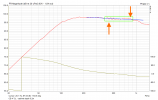
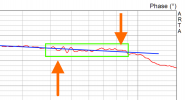
The 15'' subwoofer (cabinet depth of about 0.5m, with "normal" damping) unfortunately starts to break up at 300Hz (so we have to ignore frequencies above 300Hz). There I would assume an
average of +-0.5dB ripple over a little more than an octave.
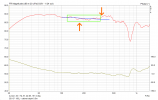
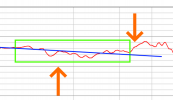
As said, if we would attribute the frequency response deviations completely to the influence of the reflected and time-delayed sound radiated through the cone.
I can't remember the sound pressure level in the near-field measurements, but assumed 95dB SPL should apply quite well.
Thus, the delayed sound radiated by the driver cone would cause a sound pressure change, in the worst case, of +-0.3dB to +-0.5dB at 95dB when added coherently - according to the examples presented.
Converting the difference from 95dB to 95.5dB (and 95.3dB), the SPL of the sound radiated through the cone would be 70dB and 66dB, respectively, an attenuation of -25dB and -29dB.
For a well damped loudspeaker, I would assume from the measurements shown that the delayed sound radiated through the driver cone is damped by significantly more than -20dB - in the shown examples shown rather -25dB to -30dB.
The -20dB attenuation quoted by
@Tangband in
post#3 seems a bit low, perhaps with lightly packed damping material.
And as
@No. 5 had already pointed out, the assumed -20dB attenuation and the attenuation from the measured examples are in an inaudible range as far as sound image and spaciousness are concerned. Sound delayed by 5ms with -20dB or more attenuation does not change the perceived sound event.
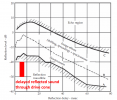
Theoretically, it would be possible to perceive a slight change in tonality in an A-B listening test if the slight octave wide ripple shown in the two examples were due to the reflected radiated sound through the driver cone.
But something like this, of course, will be triggered by any edge or transition of the speaker (due to edge diffraction) - with more impact on the frequency response.
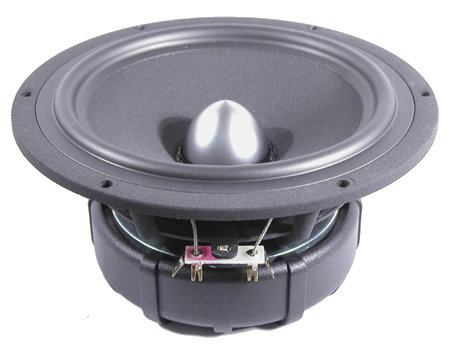
www.madisoundspeakerstore.com





